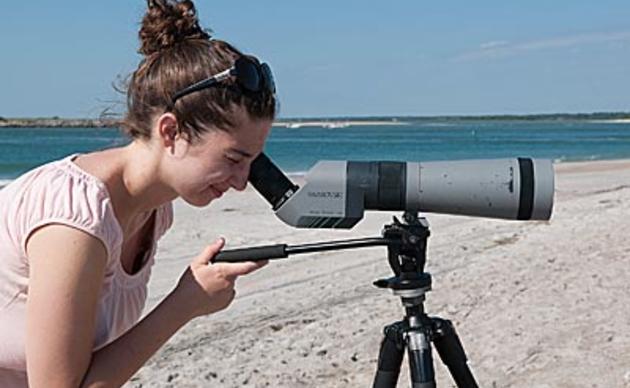Sanctuary System
More than 20 years ago, Audubon's vision for protection of North Carolina's coastal birds was to create a network of sanctuaries to protect the nesting sites of pelicans, egrets, ibis, terns and other shorebirds, and to use these sanctuaries as scientific laboratories to advance bird conservation.
Today, Audubon protects 21 sanctuaries that are essential nesting sites for more than 50,000 birds. Our sanctuaries include North Carolina's most important nesting sites like Battery Island, the state's largest wading bird colony, and Beacon Island, a sanctuary that has been essential to the recovery of Brown Pelicans.
Audubon protects 6,000 acres of marsh and maritime forest at the Donal C. O'Brien Jr. Sanctuary and Audubon Center in Corolla. This sanctuary protects thousands of wintering waterfowl each year and a significant variety of marsh birds.
North Carolina’s Audubon Sanctuary
The Audubon Sanctuary is another example of this engagement. When Audubon North Carolina assumed full management of a nearly 3,000-acre parcel of pristine marsh, uplands, dunes and maritime forest in Corolla, NC, we became the stewards of one of the last remnants of the storied Currituck Sound landscape.
Audubon now protects a mosaic of marsh, sound and forest in a region that was famed for waterfowl hunting and bass fishing, and is now a popular vacation destination.
The first Audubon Center in North Carolina came to fruition when the National Audubon Society, through the generosity of Mr. Earl Slick and his family, received ownership of parcels of land on the Northern Outer Banks, nearly 30 years ago. The family continued to use the Pine Island hunt club on the property and maintained the property until Audubon took full management a few years ago.
Lea-Hutaff Island
Lea-Hutaff Island demonstrates the power of Audubon’s steady commitment to North Carolina’s coast. Located north of Wilmington, between Figure Eight Island and Topsail Island, Lea-Hutaff Island is a 5,641-acre undeveloped barrier island and marsh system that has remained undisturbed by development, dredged sand and off-road vehicles. It has been battered by storms, flooded, over-washed and eroded, until it has now become a low, narrow ribbon of sand.
Two islands (Lea and Hutaff) joined to form this system following the closure of Old Topsail Inlet in 1998. The island is characterized by large, open expanses of bare sand caused by over-wash during hurricanes in 1996, 1998 and 1999. Remnants of primary dunes exist in a few locations along the island. One of North Carolina's few pristine barrier islands, Lea-Hutaff is an important sanctuary for wildlife, and a peaceful recreation area for people.
Audubon in partnership with the North Carolina Coastal Land Trust, the State of North Carolina and the US Fish and Wildlife Service, is leading the way to protect Lea Island through purchasing the privately owned tracts of land, so it will remain a haven for birds, turtles and other wildlife.
Currently, Audubon North Carolina has a cooperative agreement to protect and manage Hutaff Island, and Audubon staff posts and patrols tern and skimmer colonies on both islands throughout the year.
During the spring and summer, loggerhead sea turtles and hundreds of terns and skimmers nest here, and thousands of shorebirds stop off to rest during their long migrations. This narrow strip of sand has been designated as one of 96 Important Bird Areas in North Carolina.
More than 4,000 acres of tidal marsh and creeks serve as primary nursery areas for fish, shrimp and crabs, and support thousands of birds throughout the year.
The island supports thousands of shorebirds, wading birds, waterfowl and marsh birds during nesting, migration and wintering seasons. Least Terns, Black Skimmers, American Oystercatchers and Piping Plovers build their nests and raise their families on the island's bare sandy beaches. Clapper Rails nest in great numbers in the marshes and Saltmarsh, and Sharp-tailed Sparrows and Seaside Sparrows are abundant during the fall and winter.
An Important Bird Area, Beacon Island is one of nine nesting sites for Brown Pelicans in North Carolina. This 7.5-acre estuarine island supports about 9% of the North Carolina population of this species. It is located in southeastern Pamlico Sound near Ocracoke Island. The island's shoreline has eroded significantly, and more of this valuable habitat continues to be lost each year.
To address this loss of habitat for the Brown Pelican, restoration specialists with the North Carolina Coastal Federation and Audubon North Carolina partner with the local Ocracoke Island fishing community to build up the eroding shoreline using bags filled with recycled oyster shells, and by planting native marsh grasses.
During the tourism season, tour boat operators partner with Audubon North Carolina and the North Carolina Coastal Federation to engage and inform local visitors of the critical role the island plays for Brown Pelicans.
This experimental restoration work, led by Dr. Lexia Weaver of the NC Coastal Federation and initially funded through an Audubon Toyota TogetherGreen Innovation grant, will also provide a way to prevent sedimentation of the shallow waters in Pamlico Sound, which provide valuable habitat for many fish, crabs, oysters and other aquatic species.
Did this issue get you fired up? Sign-up for our NC Action Alert network to stay informed as we work to protect birds in North Carolina.
How you can help, right now
Donate to Audubon
Help secure the future for birds at risk from climate change, habitat loss and other threats. Your support will power our science, education, advocacy and on-the-ground conservation efforts.
Sign Up For Our eNewsletter
Keep up-to-date on all that happens with Audubon North Carolina's research, events and volunteer opportunities.




